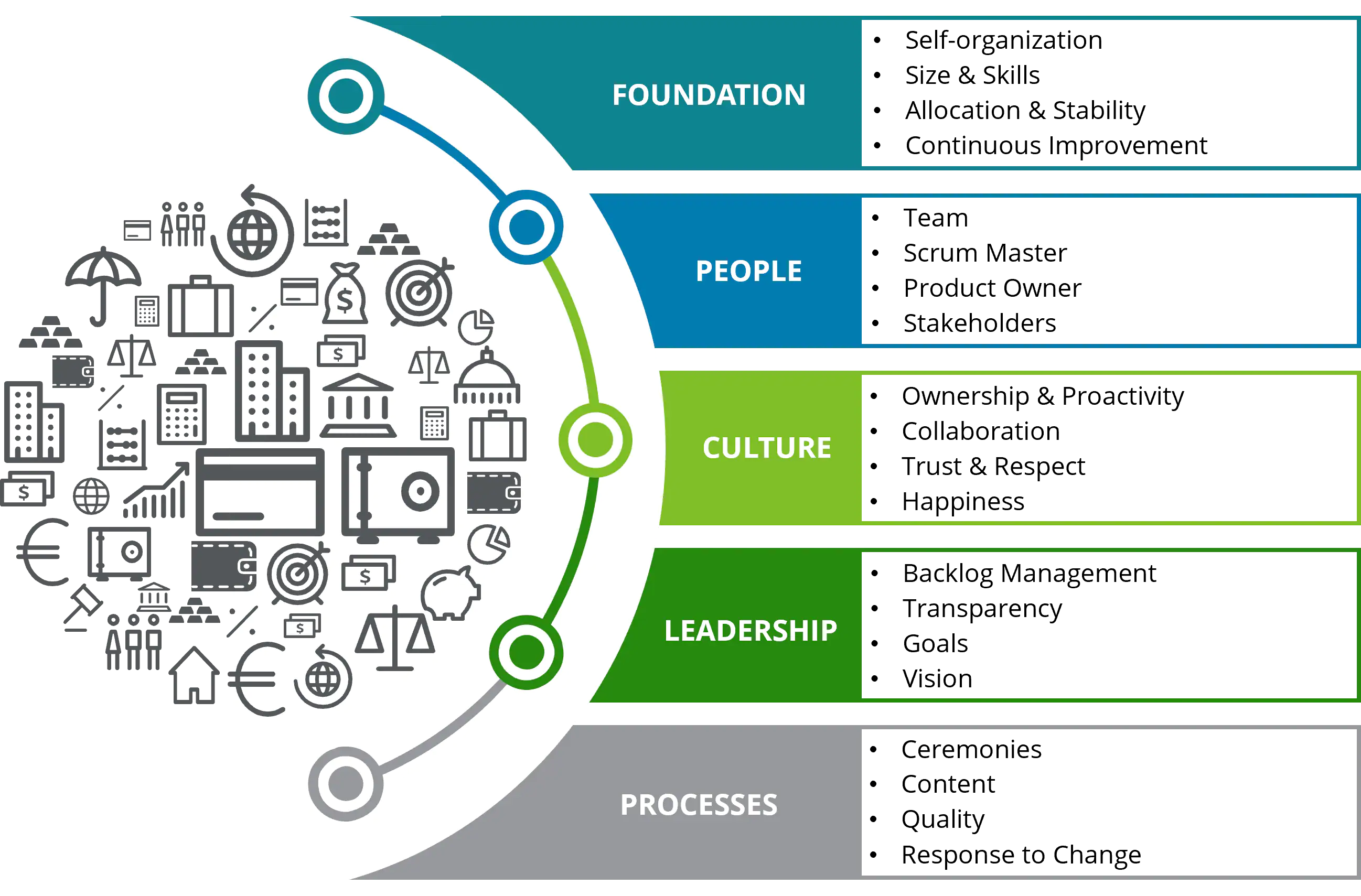Agile Maturity Index is a way to know what the degree of maturity of the team is measured by applying some method, practice, or work technique, to know the level of mastery and the degree of adoption of Agile. It gives opportunities for improvement by challenging the team to implement the best-recommended behaviors to be more effective. It also helps teams to continuous improvement, helps organizations focus people on what is most important, and generate value. In Agile Maturity Matrix focuses on five basic themes Culture, People, Foundation, Leadership, and Processes.

Some of the most popular models are:
- Squad Health Check model (Spotify)
- Tuckman Team Development Model (Bruce Tuckman)
- TeamHealth Radar Assessment (Agility health)
- Scrum Team Maturity Model
Reasons for Agile Team Assessment
- Baseline the current level of agile adoption. Eventually, you may think about measuring progress, but take the time to baseline your abilities right from the start.
- See how you’re tracking against your adoption or transformation goals. Help sustain and grow your support.
- Determine if you’re ready to move to the next level of practice or adoption. Be honest, critical, and brave!
- Recognize what has been mastered and what you are able to do with the new skill or capability. Change is tough so remember to celebrate your wins.
- Identify the next things you’re going to work on. Help the team narrow or target their focus.
- Set the context for organizational change. Use the assessment instrument as a change management tool.
- Make or support the case for needed coaching or training. Outside help can propel your progress.
Key Dimensions Evaluated
- Leadership and Culture: Examines the commitment of leadership to agile values and the prevailing organizational culture.
- Team Structure and Dynamics: Analyzes how well teams are structured and how effectively they collaborate to deliver value.
- Process and Practices: Evaluates the maturity of agile processes and practices adopted by the organization.
- Customer Centricity: Assesses the organization’s focus on customer needs and its ability to incorporate customer feedback.
- Continuous Improvement: Gauges the organization’s commitment to continuous learning, adaptation, and improvement.
Benefits of Agile Maturity Index
Provides detailed/ personalized insight – Agile Maturity Index is the best way to get to know your organization and team, its strengths, and weaknesses, and how it works in every single area. It gives real-time, continuous outputs that provide evidence of team improvements and detailed insights to drive change.
Allows improvement – This knowledge about the team and organization will allow identifying improvement areas and planning strategies. Improve your speed to market through deep insights from across your teams.
Allows you to create high-performing teams – It will allow an organization to create cross-departmental, high-performing teams focused on delivering value by identifying and breaking down silos in communication.
Increases employee’s well-being – In the Agile Maturity Index, sentiment analysis can be used to show that teams are becoming happier due to improvements being made alongside measuring the quantitative increases in performance.
Maximizes output – It will maximize the efficacy of your output by understanding and improving the connection of your teams to the company vision, value streams, and data,
Identifies influencers – It will also identify influencers within the different departments, which can be very useful to modernize and innovate your organization.
Agile Maturity Levels
Standstill (or backward) – Characterized by a lack of standardized processes and a limited understanding of agile principles. At this agile maturity level, the team either doesn’t know or has rejected the Agile values and principles. The team is often “sluggish”, slow to pivot, and struggles to deliver value quickly
Crawl – Introduction of standardized processes and practices, with teams gaining a better grasp of agile concepts. The team is starting to try one or more agile frameworks in pockets and is seeing some success. However, it is usually difficult because the teams applying the framework aren’t supported by management and may tend to slip backward.
Walk – Clear processes and practices are established and followed consistently across teams. Management is starting to support agile efforts more as they are seeing successes. Other teams are also seeing success and want to be agile, so some scaling of agile starts.
Run – Emphasis on data-driven decision-making and quantifiable metrics for continuous improvement. Projects are assigned to small teams delivering a product or service in small chunks that are short-term. Progress towards strategy is constantly evaluated and the organization adjusts accordingly. Teams are thriving.
Fly – Continuous optimization of processes, with a focus on innovation, learning, and organizational agility. The entire organization is thriving; it’s common to hear, “I love working here; I love my job.” Everyone understands and has an innate desire to work towards the goal.
Navigating the Agile Maturity Journey
- Assessment and Benchmarking: Conduct regular assessments using tools like the Agile Maturity Index to benchmark current agility levels.
- Tailored Improvement Plans: Craft customized improvement plans based on identified strengths and weaknesses.
- Continuous Learning and Adaptation: Foster a culture of continuous learning and adaptation to sustain agile maturity.
- Empowering Teams: Empower teams with the autonomy to adopt agile practices that best suit their context.
- Leadership Commitment: Ensure strong leadership commitment to agile values and principles, setting the tone for organizational agility.
- Measurable Outcomes: Define and measure key outcomes tied to agility, such as delivery speed, customer satisfaction, and adaptability.
- Feedback Loops: Establish feedback loops at various levels to gather insights and adjust strategies accordingly.
Conclusion
Understanding and leveraging the Agile Maturity Index and Agile Maturity Levels enables organizations to embark on a purposeful journey toward enhanced agility, fostering innovation, adaptability, and sustained success in the ever-evolving software development landscape.
